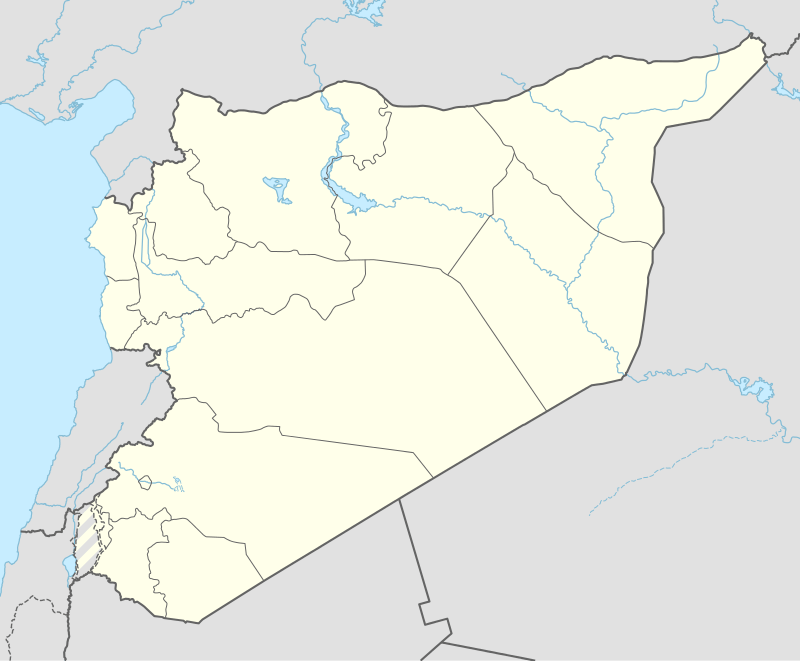Tell Ramad
Tell Ramad (Arabic: تل رماد) is a prehistoric, Neolithic tell at the foot of Mount Hermon, about 20 kilometres (12 mi) southwest of Damascus in Syria. The tell was the site of a small village of 2 hectares (220,000 sq ft), which was first settled in the late 8th millennium BC.[1]
تل رماد | |
 Shown within Syria | |
| Location | 20 km (12 mi) southwest of Damascus, Syria |
|---|---|
| Region | Damascus basin |
| Coordinates | 33.360178°N 35.948949°E |
| Type | Tell |
| Part of | village |
| Area | 2 hectares (220,000 sq ft) |
| History | |
| Material | clay, limestone |
| Founded | c. 7230–6800 BC |
| Periods | PPNA, PPNB, Neolithic |
| Site notes | |
| Excavation dates | 1963–1973 |
| Archaeologists | Henri de Contenson |
| Condition | ruins |
| Management | Directorate-General of Antiquities and Museums |
| Public access | Yes |
The tell was discovered by French customs officers, M Company and Lieutenant Potut. Laurisson Ward visited again in 1939 and collected material from the surface, now in the Peabody Museum. Tell Ramad lay somewhat forgotten until it was rediscovered by W.J. van Liere and Henri de Contenson, the latter leading excavations in 8 seasons between 1963 and 1973.[1]
Notable features from the earliest stage include a number of 3–4 metre diameter, lime-plaster floored, clay lined oval pits with ovens & clay bins that were suggested to have been used as houses.[2] There was nothing to suggest a break in occupation between level I and II of the site. Burial customs appear to have been unchanged between the two periods. Burials were mostly done in communal graves, with small deposits of grave goods. Different flint tools were found at the site in both periods, including sickles and arrowheads.[2]
Tell Ramad is notable as one of the few sites fundamental to our understanding of the origin of agriculture with finds including various types of domesticated wheat, barley and flax.[3] Emmer wheat is an important characteristic of Basin sites in this area, where it is thought to have been introduced. Wild plant foods include pistachios, almonds, figs and wild pears.[3][4] The mammal fauna from level I at Tell Ramad shows that both sheep and goats were fully and simultaneously domesticated at the site, although the sheep-to-goat ratio is more than 3 to 1.[5]
Footnotes
- Akkermans, Peter M. M. G.; Schwartz, Glenn M. (2003). The Archaeology of Syria: From Complex Hunter-Gatherers to Early Urban Societies (c. 16,000–300 BC). Cambridge University Press. p. 109. ISBN 978-0-521-79666-8.
- Moore, A.M.T. (1978). The Neolithic of the Levant. Oxford University, Unpublished Ph.D. Thesis. pp. 192–198.
- Hillman, Gordon (1978). "On the Origins of Domestic rye: Secale Cereale: The Finds from Aceramic Can Hasan III in Turkey". Anatolian Studies. 28: 157–174. doi:10.2307/3642748. JSTOR 3642748.
- Fu, Yong-Bi (2011). "Genetic evidence for early flax domestication with capsular dehiscence". Genetic Resources and Crop Evolution. 58 (8): 1119–1128. doi:10.1007/s10722-010-9650-9.
- Harris, David R. (1996). The origins and spread of agriculture and pastoralism in Eurasia. Routledge. p. 253. ISBN 978-1-85728-538-3.
Further reading
- de Contenson, H. Cauvin, M.-C. Courtois, L. Ducos, P. Dupeyron, M. van Zeist, W. - Ramad. Site Néolitique en Damascène (Syrie) aux VIIIe et VIIe Millénaires Avant l´Ère Chrétienne, Bibliothèque Archéologique et Histoire, Tome 157, Beirut, 2000.
- van Zeist, W. Bakker-Heeres, J.A.H. - Archaeobotanical Studies in the Levant 1. Neolithic Sites in the Damascus Basin: Aswad, Ghoraifé, Ramad - Palaeohistoria, 24, 165-256, 1982.
- Vogel, J.C. Waterbolk, H.T. - Groningen Radiocarbon Dates VII - Radiocarbon, 9, 107-155, 1967.
- Ferembach, D. - Étude anthropologique des ossements humains néolithiques Tell Ramad (Syrie). Annales archéologiques de Syrie, 19, 49-70, 1969.
- de Contenson, H. Troisiéme campagne á Tell ramad 1966: rapport préliminaire. Annales Archéologiques de Syria XVII (1–2), 17–24, 1967.
- de Contenson, H. Découvertes récentes dans la domaine du Néolithique en Syrie, L'Anthropologie, 70, 388-391, 1966.
- de Contenson, H. van Liere, W.J. Premiers pas vers une chronologie absolue à Tell Ramad, Annales Archéologiques Arabes Syriennes, 16, 175-176, 1966.
- de Contenson, H. van Liere, W.J. Sondages à Tell Ramad en 1963: rapport préliminaire, Annales Archéologiques Arabes Syriennes, 14, 190, 1964.
- de Contenson, H. van Liere, W.J. A Note on Five Early Neolithic Sites in Inland Syria 13, 175-209, 1963.